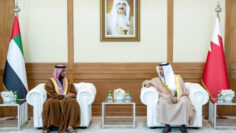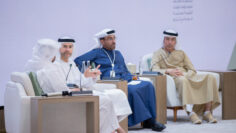Mineral Garden Exhibition: Brazilian artist reimagines mining waste as art in Abu Dhabi
ABU DHABI, 21st January, 2025 (WAM) — Brazilian artist Ana Elisa Murta brings her exhibition Mineral Garden to Abu Dhabi, offering a fresh perspective on art and sustainability. By transforming mining waste into natural pigments, Murta reimagines discarded materials, creating non-toxic paints used in vibrant visual compositions. The exhibition is on display at the Bassam Freiha Art Foundation in Abu Dhabi from 19th December 2024 to 16th February 2025.
With a keen eye for the relationship between territories, Murta’s work establishes a connection between the mountains of Minas Gerais – a Brazilian state renowned for its extensive mining activity – and the dunes of the UAE. The artist explores the similarities and contrasts between these natural environments, such as the solidity of rocks and the fluidity of sand, to create a visual and symbolic narrative that speaks of permanence, transience and the coexistence of natural forces.
The origin of pigment: from waste to art
The idea of creating pigments from mining residues arose from Ana Elisa Murta’s personal need. During her career, she developed a severe allergy to conventional paints, which often contain harmful chemicals associated with health risks. “It was then that I realised that pigment, the most valuable raw material in paints, was abundant around me, in the rocks and soil of Minas Gerais,” Ana Elisa told the Emirates News Agency (WAM).
Minas Gerais, with its vast mining activity, generates enormous amounts of mineral waste – materials that, although discarded, hold valuable artistic properties. Inspired by the pigments present in these residues, the artist began collecting small quantities of materials from mines near Belo Horizonte. The process involves crushing, sieving, washing, and purifying the minerals to obtain a fine powder that, when mixed with oils, produces paints similar to those used by Renaissance artists.
“The mountains of Minas bring a dense geological time, rich with history. Meanwhile, the dunes of the Emirates, in constant transformation, represent ephemerality. By uniting these elements, I propose a dialogue about the permanent and the transient, between the raw and the delicate,” tells the Brazilian artist.
A palette of colours: between earthy tones and golds
In the exhibition “Mineral Garden”, the colour palette emerges from this meeting of continents. Earthy tones, extracted from the mineral residues of Minas Gerais, blend with gold hues inspired by the sands of the Emirati dunes. The result is a vast range of colours that reveal vibrant and luminous nuances, redefining what was once waste into something precious.
Ana Elisa Murta highlighted the technical challenges of obtaining natural pigments with quality and consistency. “It required meticulous work, from selecting and purifying the material to formulating the paints. However, the process carries a powerful symbolic dimension: the transformation of discarded material into something beautiful and meaningful.”
A cultural dialogue through art
The exhibition also seeks to provoke reflections in the audience about the relationship between materials, nature, and waste. “We aim to awaken a more attentive and sensitive view of the stories that materials carry. Each mineral fragment transformed into pigment holds a memory of time and of humanity’s relationship with nature,” the artist said.
In the UAE, the exhibition promises to expand the dialogue between the two territories, bringing together cultures that, despite being geographically distant, share similar challenges regarding the extraction and sustainability of natural resources. “This exchange between Brazil and the UAE can expand into future projects, creating new opportunities for collaboration and cultural exchange,” Ana Elisa believed.
“We want the audience to see the beauty that exists in the imperfect, the traces, and the residual. Art has the power to transform not only materials but also perceptions and sensitivities,” she concluded.
In “Mineral Garden”, Ana Elisa creates a space of encounter between nature, cultures, and time, where transformation becomes visible and beauty emerges from what was once rejected.








